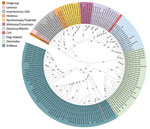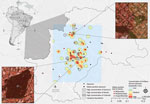Volume 29, Number 12—December 2023
Dispatch
Naturally Acquired Rabies in White-Eared Opossum, Brazil
Abstract
Opossums are considered resistant to rabies. Nonhematophagous bats are reservoirs of rabies in urban areas of South America. We analyzed bats and opossums tested for rabies during 2021 in a highly urbanized city in Brazil to understand spillover in an urban setting. Wildlife surveillance is necessary to prevent rabies in humans and domestic animals.
Rabies is a viral zoonosis with high mortality rates caused by Lyssavirus rabies lineages (rabies virus, RABV) (1). Opossums of the genus Didelphis are marsupials widely distributed in the Americas, synanthropic in urban scenarios, and considered resistant to RABV (2). The main urban reservoirs of RABV in Brazil are nonhematophagous bats with distinct lineages and epidemiologic aspects (3). In 2021, passive surveillance programs detected an unusual case of rabies in a white-eared opossum (D. albiventris) by a RABV lineage of frugivorous bats of genus Artibeus spp. in Campinas, São Paulo state, Brazil, the 10th most urbanized city in the country (4). To elucidate the dynamics of this spillover, we describe the results of passive surveillance for rabies in bats and opossums in Campinas in 2021.
In 2021, we tested samples of frozen brain tissue from 930 bats and 22 opossums for rabies by direct fluorescent antibody test and confirmed infection by virus isolation in cell culture (5) in Campinas. Fixed formalin brain tissue fragments in 15 of these 22 opossums were analyzed by histopathology. In addition, for the opossum that tested positive for rabies, we performed reverse transcription PCR and subsequent phylogenetic analysis of the glycoprotein gene of RABV in the frozen brain tissue and conducted immunohistochemical analysis for rabies in fixed formalin tissues (cerebrum, cerebellum, heart, lungs, liver, spleen, kidney, and adrenal glands) (Appendix 1; Appendix 2). Ethics approval was granted by the Ethics Committee in the Use of Animals of the School of Veterinary Medicine and Animal Science, University of São Paulo (approval no. 8227140222), according to the Ethical Principles in Animal Research.
Of the 22 opossums tested for rabies, 1 (4.5%) adult female white-eared opossum (D. albiventris) had a positive result. Death was caused by traumatic lesions in 10 (45.4%) opossums; 4 (18.2%) of those deaths were caused by interspecies interactions with dogs. Of the 15 opossums analyzed by histopathology, 14 (93.3%) were found in the urban zone, inside households in densely urbanized areas, or in residences on the outskirts of the city; death was caused by traumatic lesions in 10 (66.7%) opossums, 4 of those deaths were caused by interspecies interactions with dogs. On histopathologic examination, we observed no lesions in 8 opossums, hemodynamic lesions in 4, autolysis in 2, and mononuclear meningoencephalitis in the rabies-positive opossum (Appendix 1 Figure 1). In the rabies-positive opossum, RABV antigen was detected by immunohistochemistry in the cerebrum (Appendix 1 Figure 2), cerebellum, adrenal gland, liver, and heart. The RABV-positive opossum was found in a zoo located within a park in the urban center of Campinas and demonstrated signs of the paralytic form of RABV infection. Phylogenetic reconstruction demonstrated that the RABV clustered within the frugivorous fruit-eating bats (Artibeus spp.) lineage circulating in Brazil (GenBank accession no. ON604858) (Figure 1).
During 2021, the frequency of rabies detected in bats was 3.2% (30/930). Among the rabies-positive bats, 17 (56.7%) were frugivorous species of fruit-eating bats (Artibeus spp.); the other 13 (43.4%) were insectivorous bats of Eptesicus spp., Myotis spp., and Tadarida spp. (Appendix 2 Table 3). In total, bats from those 4 genera represented 153 (16.4%) of the total bats investigated. Bats were tested periodically, and different seasonality peaks were noted in frugivorous and insectivorous bats (Appendix 1 Figures 5, 6). Rabies-positive bats were found in the urban perimeter of the municipality of Campinas; 73.3% were found in areas of sparse vegetation and 26.7% in areas of remnants of vegetation (Appendix 1 Table). We identified bats in a regular spatial distribution throughout the city; we observed a small area of concentration in the north and a slight concentration of rabies-positive bats in the center of the city (Appendix 1 Figure 3). According to genus classification, Artibeus spp. bats were found in medium and high concentrations and overlapped spatially with a high concentration of insectivorous bats. Of note, opossums were found near areas of medium to high bat concentrations, and the rabies-positive opossum was captured in a vegetated area with a high concentration of Artibeus spp. bats (Figure 2). We also found a spatial diffusion of Artibeus spp. bats that overlapped with the rabies-positive opossum (Appendix 1 Figure 4), demonstrating a time overlap in August 2021.
Experimental virus inoculation in the 1960s led to initial suggestions of resistance to infection by RABV in Didelphis spp. opossums. (7). Reports of RABV in opossums are scarce; their low body temperature (34.4–36.1°C [94–97°F]) and the minimal possibility of surviving an attack by a rabid animal have been suggested as probable causes of the low prevalence of this disease in opossums in North America, where wild carnivorous mammals are natural reservoirs (2). Despite the low reports of rabies in opossums, a seroprevalence study conducted in São Paulo state observed a prevalence of RABV of 1.6% (5/312) in Didelphis spp., indicating contact between this animal population and RABV (8). Neurologic signs demonstrated by the rabies-positive opossum in this study are associated with paralytic form rabies, a common form transmitted by bats (9), and detection of viral particles in other organs indicates a phase of systemic spread. Interspecies interactions with bats in urban centers could be hypothesized as a route of RABV to the opossum, as has been observed in recent episodes of RABV in cats in Campinas (10,11). Unlike the scenario described in North America (2), opossums might survive interactions with bats. Opossum deaths detected in this study occurred in anthropic areas of the city; they were more prevalent in homes and were caused by traumatic events, such as attacks by dogs, warning of the possible risk for infection with RABV in domestic animals.
Frugivorous and insectivorous bats are reservoirs of RABV in urban centers of South America; bat lineages are replacing RABV canid lineage after successful vaccination efforts were adopted in Brazil in the dog population (11,12). The spatial distribution of captured bats and opossums revealed an overlap in habitats between rabies-positive bats and opossums in urban areas. The rabies-positive opossum was found in a vegetated area within a very urbanized area densely occupied by Artibeus spp. bats; those areas of dense bat population might create conditions in which rabies transmission, and development of new hosts and strains, is more tied to ecologic factors than to the phylogenetic characteristics of the hosts (13). In São Paulo state, vaccination campaigns for dogs and cats were discontinued after dog RABV lineages had not been detected for >20 years. Spillover cases such as those described in this study indicate the importance of wildlife mammal surveillance to detect RABV, particularly in urban areas, where those animals can assume the role of host and act as a source of infection for humans. Spatial analysis can be a powerful tool to assist in rabies surveillance. Although some studies have conducted mapping of bat populations in cities in Brazil (11,14), such studies are scarce and need structured surveillance programs with trained teams. In addition, we noted seasonality in the RABV bat genus and in rabies-positive bats; insectivorous bats were commonly positive in summer and spring and the frugivorous genus Artibeus bats were more commonly positive in fall and winter, as described by Dias et al. (11).
This case shows that opossums are susceptible to rabies and can potentially acquire RABV from bats, as was suggested by the ecospatial analysis. Elucidating this possibility—through the detection of the dead opossum—occurred through integrated surveillance involving motivated field and laboratory teams. Our findings highlight the need for continuous surveillance of wildlife to clarify the dynamics of zoonotic diseases and to prevent their occurrence in humans and domestic animals, in agreement with a One Health approach.
Mr. Ferreira-Machado is a PhD candidate in the school of Veterinary Medicine and Animal Sciences, University of São Paulo, São Paulo, Brazil. His primary research interests are wildlife comparative pathology and wildlife infectious diseases.
Acknowledgments
We thank all members of the Surveillance Unit in Zoonoses, Bosque dos Jequitibás Zoo, Laboratory of Zoonoses and Vector-borne Diseases, Biological Sample Management Center, and Pathology Center of Adolfo Lutz Institute.
This study was supported by Conselho Nacional de Desenvolvimento Científico e Tecnológico (CNPq) process number 404510/2021; Grupo de Apoio às Políticas de Prevenção e Proteção à Saúde/Fundo Especial de Saúde para Imunização em Massa e controle de Doenças (GAPS/FESIMA grant nos. 040/2019 and 28/2020); and The São Paulo Research Foundation—FAPESP (processes nos. 2022/02242-0 and 2023/04780-2). J.L.C.-D. is the recipient of a professorship from CNP (304106/2022-4).
References
- Scott TP, Nel LH. Lyssaviruses and the fatal encephalitic disease rabies. Front Immunol. 2021;12:
786953 . DOIPubMedGoogle Scholar - Diana NK, Mitchell KC, Feldman KA. Shedding light on rabies in opossums. J Am Vet Med Assoc. 2015;247:1229.PubMedGoogle Scholar
- Castilho JG, de Souza DN, Oliveira RN, Carnieli P Jr, Batista HBCR, Pereira PMC, et al. The epidemiological importance of bats in the transmission of rabies to dogs and cats in the state of São Paulo, Brazil, between 2005 and 2014. Zoonoses Public Health. 2017;64:423–30. DOIPubMedGoogle Scholar
- Brazilian Institute of Geography and Statistics (IBGE). Cities and states: Campinas Panorama [cited 2023 Jul 2]. https://cidades.ibge.gov.br/brasil/sp/campinas/panorama
- World Organization of Animal Health (WOAH). Chapter 3.1.18. Rabies (infection with rabies virus and other lyssaviruses). In: WOAH Terrestrial Manual 2023 [cited 2023 Mar 2]. https://www.woah.org/fileadmin/Home/eng/Health_standards/tahm/3.01.18_RABIES.pdf
- Letunic I, Bork P. Interactive Tree Of Life (iTOL) v5: an online tool for phylogenetic tree display and annotation. Nucleic Acids Res. 2021;49(W1):W293–6. DOIPubMedGoogle Scholar
- Beamer PD, Mohr CO, Barr TR. Resistance of the opossum to rabies virus. Am J Vet Res. 1960;21:507–10.PubMedGoogle Scholar
- Fornazari F, Scheffer KC, Dos Ramos Silva S, da Silva KR, Rodrigues AC, Teixeira CR, et al. Seroprevalence to rabies virus in wildlife in Brazil. J Wildl Dis. 2022;58:431–5. DOIPubMedGoogle Scholar
- Udow SJ, Marrie RA, Jackson AC. Clinical features of dog- and bat-acquired rabies in humans. Clin Infect Dis. 2013;57:689–96. DOIPubMedGoogle Scholar
- Gazarini J, Brito JE, Bernardi IP. Opportunistic predations of bats by Didelphis albiventris in southern Brazil [in Portuguese]. Chiroptera Neotropical. 2008;14:408–11.
- Dias RA, Rocha F, Ulloa-Stanojlovic FM, Nitsche A, Castagna C, de Lucca T, et al. Spatiotemporal distribution of a non-haematophagous bat community and rabies virus circulation: a proposal for urban rabies surveillance in Brazil. Epidemiol Infect. 2019;147:
e130 . DOIPubMedGoogle Scholar - Queiroz LH, Favoretto SR, Cunha EM, Campos AC, Lopes MC, de Carvalho C, et al. Rabies in southeast Brazil: a change in the epidemiological pattern. Arch Virol. 2012;157:93–105. DOIPubMedGoogle Scholar
- Caraballo DA, Lema C, Novaro L, Gury-Dohmen F, Russo S, Beltrán FJ, et al. A novel terrestrial rabies virus lineage occurring in South America: origin, diversification, and evidence of contact between wild and domestic cycles. Viruses. 2021;13:2484. DOIPubMedGoogle Scholar
- Ribeiro J, Staudacher C, Martins CM, Ullmann LS, Ferreira F, Araujo JP Jr, et al. Bat rabies surveillance and risk factors for rabies spillover in an urban area of Southern Brazil. BMC Vet Res. 2018;14:173. DOIPubMedGoogle Scholar
Figures
Cite This Article1These first authors contributed equally to this article.
2These senior authors contributed equally to this article.
3These authors were co–principal investigators.
Table of Contents – Volume 29, Number 12—December 2023
| EID Search Options |
|---|
|
|
|
|
|
|


Please use the form below to submit correspondence to the authors or contact them at the following address:
Eduardo Ferreira-Machado, 87 Av. Prof. Dr. Orlando Marques de Paiva, Butantã, São Paulo, 05508-270, São Paulo, Brazil
Top